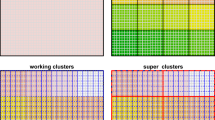Abstract
A method of sampling and analysis is proposed to detect pattern parameters in plant populations from two-dimensional data. the use of aerial photographs to find the coordinates of trees and the measurements of plant-to-all-plants distances yields conditioned probability spectra which can be interpreted in terms of pattern parameters. Two artificial populations and a set of real data have been analysed to test the accuracy of the method.
Similar content being viewed by others
References
Clark, P. J. & Evans, F. C., 1954. Distance to neighbor as a measure of spatial relationships in populations. Ecology 35: 445–453.
Clark, P. J. & Evans, F. C., 1979. Generalization of a nearest neighbor measure of dispersion for the use in K dimensions. Ecology 60: 316–317.
Dice, L. R., 1952. Measure of the spacing between individuals within a population. Contrib. Lab. Vert. Biol. Univ. Mich. 55: 21–33.
Greig-Smith, P., 1961. Data on pattern within plant communities. I. The analysis of pattern. J. Ecol. 49: 659–708.
Greig-Smith, P., 1964. Quantitative Plant Ecology. 2nd ed. Butterworths, London.
Greig-Smith, P., 1979. Pattern in vegetation. J. Ecol. 67: 755–779.
Hopkins, B., 1954. A new method for determining the type of distribution of plant individuals. Ann. Bot. Lond. 18: 213–223.
Nicolas, J. P., Galiano, E. F. & Quintas, M. A. G., 1981. Análisis de la microestructura espacial de la vegetacion de pastizales. Studia oecologica 1: 109–130.
Pielou, E. C., 1959. The use of point-to-plant distances in the study of the pattern of plant populations. J. Ecol. 47: 607–613.
Pielou, E. C., 1960. A single mechanism to account for regular, random and aggregated populations. J. Ecol. 48: 575–583.
Pielou, E. C., 1961. Segregation and symmetry in two-species populations as studied by nearest neighbour relationships. J. Ecol. 49: 255–269.
Simberloff, P., 1979. Nearest neighbour assessment of spatial configurations of circles rather than points. Ecology 60: 679–689.
Skellam, J. G., 1952. Studies in statistical ecology. I. Spatial pattern. Biometrika 39: 346–362.
Thompson, H. R., 1956. Distribution of distance to nth nearest neighbour in a population of randomly distributed individuals. Ecology 27: 391–394.
Author information
Authors and Affiliations
Rights and permissions
About this article
Cite this article
Galiano, E.F. Pattern detection in plant populations through the analysis of plant-to-all-plants distances. Vegetatio 49, 39–43 (1982). https://doi.org/10.1007/BF00051564
Accepted:
Issue Date:
DOI: https://doi.org/10.1007/BF00051564




